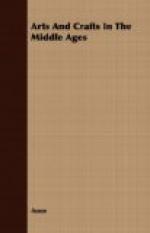In the south transept at Amiens is a piece of elaborate sculpture in four compartments, which are the figures of many saints. There is a legend in connection with those figures: when the millers were about to select a patron saint, they agreed to choose the saint on whose head a dove, released for the purpose, should alight; but as the bird elected to settle on the head of a demon, they abandoned their plan! The figures in these carvings are almost free of the ground; they appear to be a collection of separate statuettes, the scenes being laid in three or four planes. It is not restrained bas-relief; but the effect is extremely rich. The sculptures in high relief, but in more conventional proportion than these, which occur on the dividing wall between the choir and the north aisle, are thoroughly satisfactory. They are coloured; they were executed in 1531, and they represent scenes in the life of the Baptist. In the panel where Salome is portrayed as dancing, a grave little monkey is seen watching her from under the table. The similar screen surrounding the sanctuary at Paris was the work of the chief cathedral architect, Jean Renoy, with whom worked his nephew, Jehan le Bouteiller. These stone carved screens are quite usual in the Ile de France. The finest are at Chartres, where they go straight around the ambulatory, the whole choir being fenced in, as it were, about the apse, by this exquisite work. This screen is more effective, too, for being left in the natural colour of the stone: where these sculptures are painted, as they usually are, they suggest wood carvings, and have not as much dignity as when the stone is fully recognized.
The Door of St. Marcel has the oldest carving on Notre Dame in Paris. The plate representing the iron work, in Chapter IV., shows the carving on this portal, which is the same that has Biscornette’s famous hinges. The central figure of St. Marcel himself presents the saint in the act of reproving a naughty dragon which had had the indiscretion to devour the body of a rich but wicked lady. The dragon is seen issuing from the dismantled tomb of this unfortunate person. The dragon repented his act, when the saint had finished admonishing him, and showed his attachment and gratitude for thus being led in paths of rectitude, by following the saint for four miles, apparently walking much as a seal would walk, beseeching the saint to forgive him. But Marcel was firm, and punished the serpent, saying to him: “Go forth and inhabit the deserts or plunge thyself into the sea;” and, as St. Patrick rid the Celtic land of snakes, so St. Marcel seems to have banished dragons from fair France.
[Illustration: CARVINGS AROUND CHOIR AMBULATORY, CHARTRES]
At Chartres there are eighteen hundred statues, and almost as many at Amiens and at Rheims and Paris. One reason for the superiority of French figure sculpture in the thirteenth century, over that existing in other countries, is that the French used models. There has been preserved the sketch book of a mediaeval French architect, Vilard de Honcourt, which is filled with studies from life: and why should we suppose him to be the only one who worked in this way?




